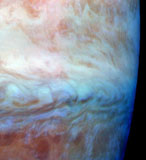![]()
Galileo's main piece of equipment is called a Solid-State Imaging instrument (SSI), which takes photos in visible light, but this is not Galileo's only camera; there are three other cameras on board. A photopolarimeter-radiometer measures the polarization of light scattered from Jupiter's clouds and the satellites' surfaces. The process it uses is very much like using polarized sunglasses to cut down on glare. In addition, its infrared channels will probe the atmosphere and measure the temperature of objects surrounding Jupiter, such as its moons. The near-infrared mapping spectrometer will map Jupiter's moons, looking for different minerals across their surfaces. It will also study cloud structure and gas composition in the atmosphere around Jupiter. An ultraviolet spectrometer and extreme ultraviolet spectrometer will study the materials Jupiter's moons are made of, certain physical properties of the Jupiter clouds, and the composition, structure, and evolution of Jupiter's upper atmosphere. All four of these cameras are mounted on a scan platform, located near the bottom of the orbiter. This is the despun section; it is not spinning like the orbiter.
This image, taken with Galileo's SSI, shows an area of Jupiter's equator. It was taken on Nov. 5, 1996, at a range of 1.2 million kilometers by Galileo's space probe.
